SEE ALSO: COLUMBIA (EMI) – the main Columbia article

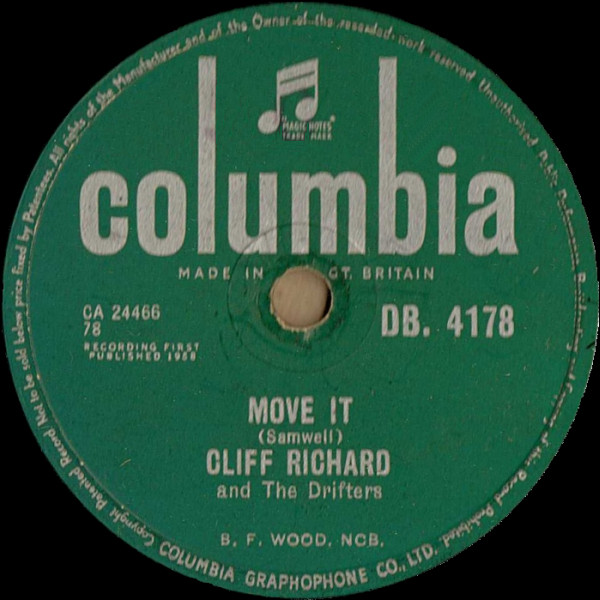

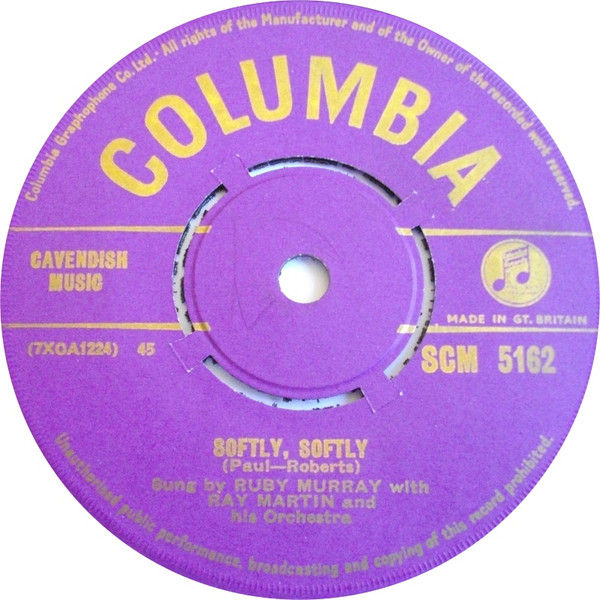
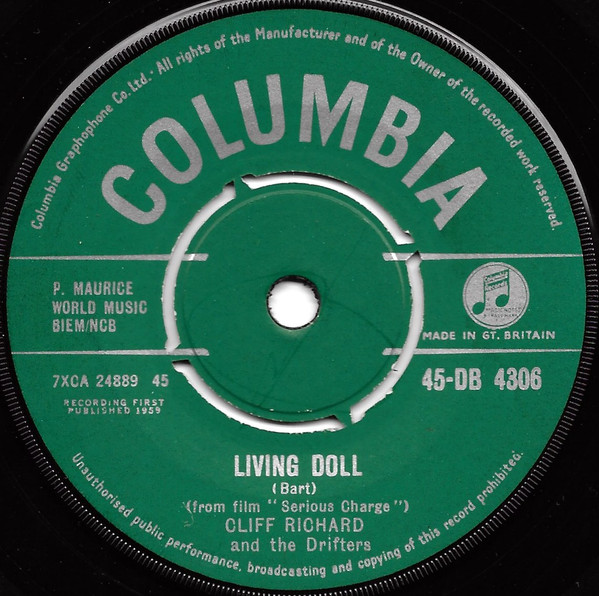
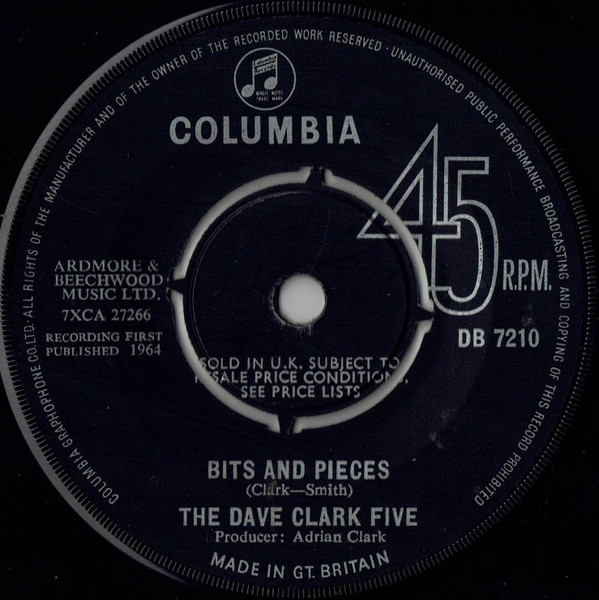
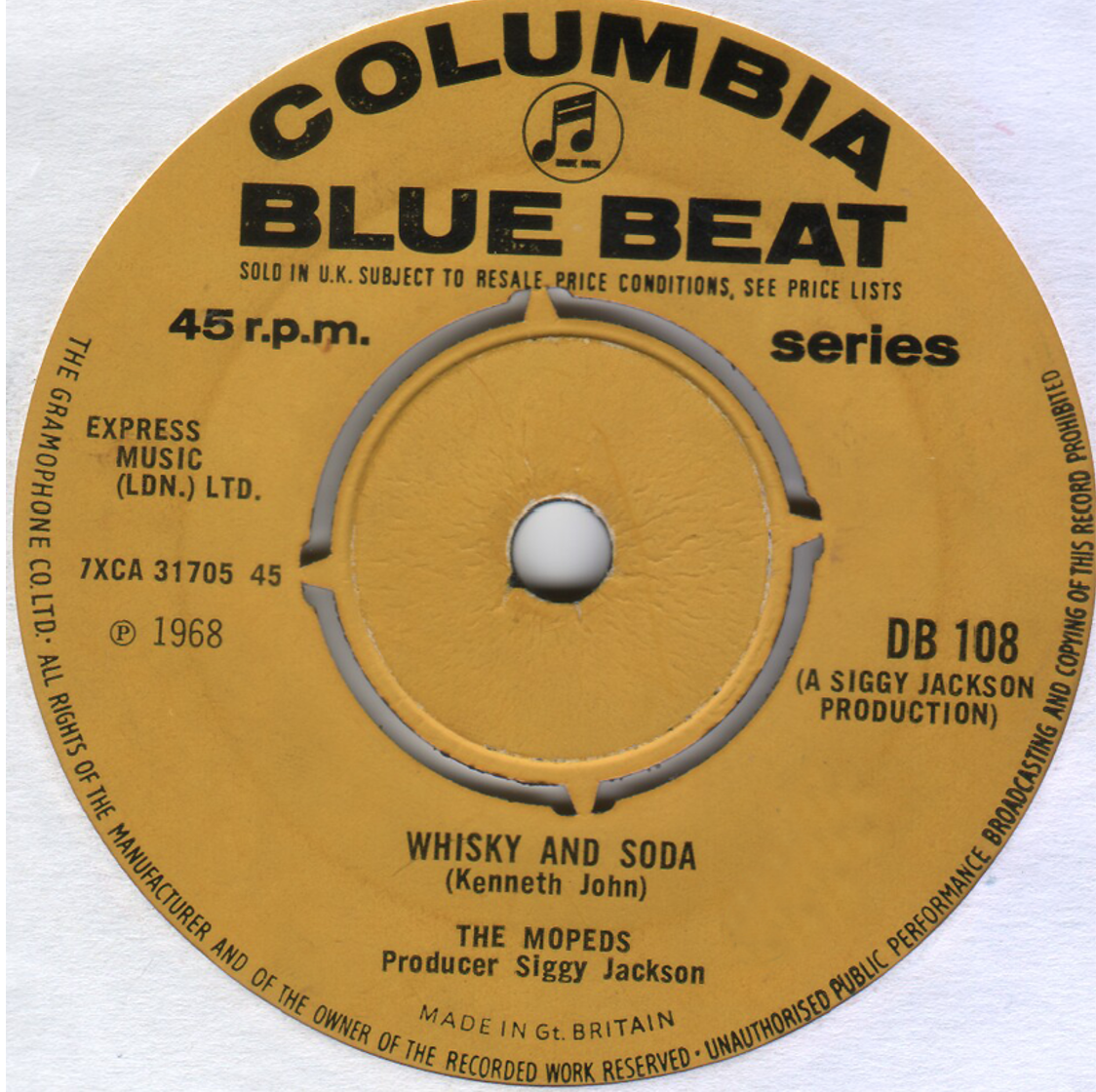



Which ones go in which sleeves?
When you leaf through a box of old singles, certain sleeves cause a tiny quiver of anticipation before you pick out the record to see what it is. Immediate, Pye International, Stateside, London-American all give you that frisson… but Columbia is not one of those labels. The expectation is lower, partly because there’s so much of it. And a great deal of what there is will be Russ Conway, Frank Ifield, Cliff Richard, The Shadows or Acker Bilk. Columbia was EMI’s premier popular label from 1958 through to 1970.


1954: 78 rpm 10″ sleeve
The very first EMI 45 single was Ray Martin’s Blue Tango (SCM 5001). The record featured at #8 in the first-ever British chart in November 1952, which would have been based on 78 rpm sales. The 45 rpm version appeared in 1953. It’s on thinner vinyl than the later norm, but plays perfectly at seventy years old.

Blue lettering (galleries click to enlarge images)
Popular records had mauve labels and classical blue. In the EMI, Pye and Decca groups, colour coding on labels weren’t designed so much to indicate genre, but were a pricing guide, and classical were more expensive, but described in catalogues as ‘dark blue label’ rather than classical. The sleeves had blue lettering and instructions in small red type at the top. A number of 1953-54 discs have turned up in plain brown paper sleeves, which look as if they’ve always been with them. Perhaps it was the default if they ran out. Early 45 rpm records had gold lettering across the EMI group, as they did with Decca’s London label. Both groups switched from gold to silver lettering in early 1957, and copies exist in both silver and gold for that year.



Hallelujah Chorus from “Messiah”: Huddersfield Choral Society. SCO 2017, 1953. Blue centre for classical. Gold lettering
Etude in E Major, Chopin: Malcuzynski 1953 SCB 104, bright blue gold lettering Classical
King of The Zulus: Louis Armstrong & His Hot Five, November 1953, SCM 5061, gold on centre, blue on sleeve, no red lettering at the top
black lettering
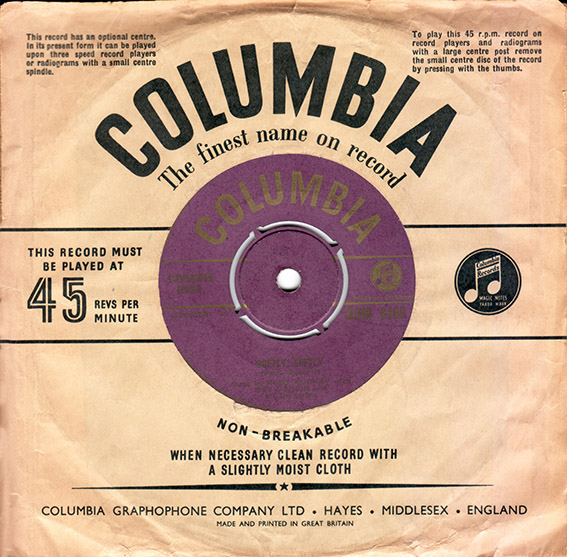

Softly Softly: Ruby Murray 1955, black with large hole instructions SCM 5162
Stranger in Paradise: Ronnie Harris reverse of black sleeve SCM 5176
red lettering


Cherry Pink (& Apple Blossom White) Eddie Calvert 1955
You can see why EMI (and Decca) switched from gold to silver label lettering. With age the gold becomes near illegible.


I Love You Baby: Paul Anka November 1957 (sleeve numbered top right) Silver. Post-1955 sleeve.
The Skaters – Waltz: Philharmonia Orchestra. An ice-rink fave rave from the mid 1950s. Classical blue, silver lettering
The “dancing” sleeve
The ‘dancing sleeves’ came in for HMV, Columbia and Parlophone arrived in 1957. They’re dancing on the 45 sleeves but the couple are sitting on the Columbia 78 one.


I’m Not A Juvenile Delinquent: Frankie Lymon & The Teenagers. 78 rpm 1957. 78 version of dancing sleeve
On A Christmas Day: Lonnie Donegan, 78 rpm reverse of sleeve
Initially they retained a purple centre matching the sleeve on 45s. Some have a different centre hole position. This one is a numbered sleeve. It had the wrong disc inside, but for illustration I’ve left the wrong one there. With Decca labels, smaller holes meant earlier. In this case I think it’s just a different print run and not so much smaller as placed further left before the sleeve was wrapped around. Note the space between the centre and the legs to the right, then the standard light on the left, and compare it to the ones below, which are earlier AND later. Then that space can also be found much later.
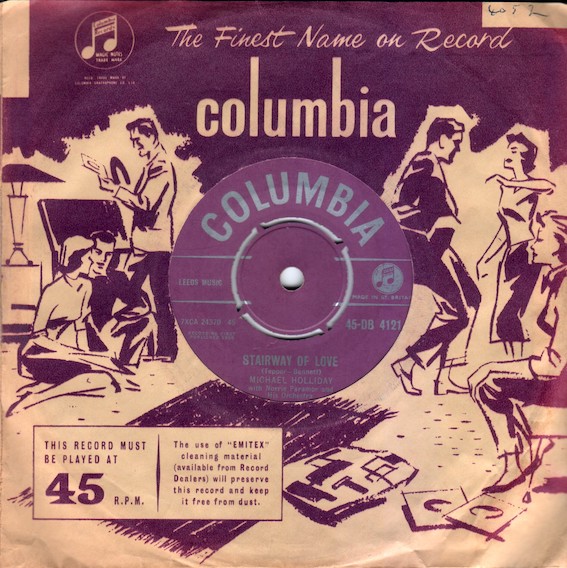
December 1957, #DB 4052 with smaller centre hole- note the legs to the right (wrong disc inside to illustrate)


Goody Goody: Frankie Lymon & The Teenagers July 1957, #DB 3983
Lollipop: The Mudlarks March 1958 Purple centre, large hole #DB 4099 reverse
Green centre label
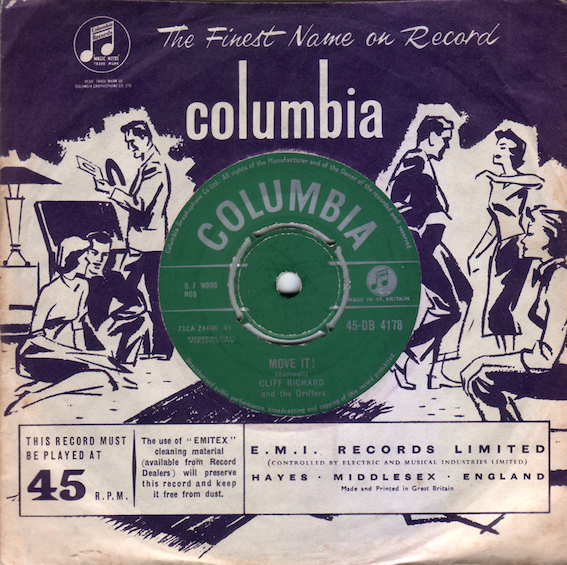

Move It!: Cliff Richard & The Drifters September 1958. DB 4178. Dancing sleeve. Green centres, till late 1959
Roulette: Russ Conway 1959, DB4298. Other side of sleeve. White numbering boxes seem to come and go. Sleeves with boxes are lighter purple


Travellin’ Light: Cliff Richard & The Shadows. July 1959. Last Cliff single in a purple sleeve. reverse sleeve, DB 4351
Saturday Dance: The Shadows July 1959 front sleeve, DB 4387
You can’t tell from the green centre labels (which ran from 1957 to late 1962) which sleeve matches a record … purple dancing sleeve, circles or stripes. A dealer-numbered copy of Michael Holiday’s Starry-Eyed (45-DB-4378) is in a circles sleeve. The record was released in July 1959, but didn’t chart till January 1960, and was in the chart for thirteen weeks.
Cliff is a good way to date stuff. I found a set of Cliff Richard singles in a plastic sleeved album, all near mint, and with acquisition dates from someone who bought them on release. As records stayed in print for years the sleeves on re-pressings were whatever was the current stock sleeve. This album proved which sleeves Cliff Columbia singles were in on first release.
Circles or Discs sleeve
EMI’s geometric series.
Up to Travelling Light in October 1959, all Cliff Richard singles had green centres and purple sleeves, and each had a 78 rpm version. From A Voice in The Wilderness in January 1960, they have the circles sleeve which never went to 78s. A Voice in the Wilderness is also the final Cliff 78 rpm release, but the 10” version appeared in the older purple sleeve..


The Frightened City: The Shadows May 1961 DB4637, non-address side. Front. Circles sleeve Jan 1960 – early 1962, redder version
A Voice In The Wilderness: Cliff Richard January 1961 DB4398, address side of sleeve. pinker, dealer numbered
There are pinker versions and redder versions. Some may be fading, but I think they’re different printings or different printers, in the same way there appear to be two versions of the dancing sleeve.. Both of the ones below have hard colours with no sign of fade.

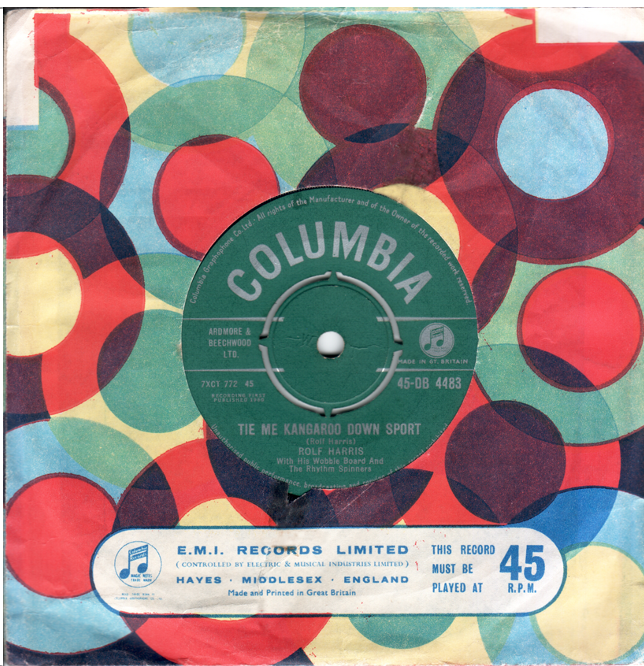
You Don’t Know: Helen Shapiro July 1961 DB 4670 pinkier ones said to be earlier (but I disagree)
Tie Me Kangaroo Down Sport: Rolf Harris July 1960 addressside, redder DB 4483
Contrary to what some guides say, first copies of The Young Ones in January 1962 were in the circles (i.e. discs) sleeves. Later in its chart run the sleeve switches to stripes, say after February 1962.
stripes sleeve


Bristol Twistin’ Annie: The Dovells. DB 4877, Striped label, July 62. Design for 1962, green centre. License from Cameo-Parkway
English Country Garden: Jimmy Rodgers July 1962 DB 4847 rear of striped sleeve has LP adverts. Only one version of ads too.


What Kind of Love Is This? Joey Dee & The Starliters, DB4905 1962, license from Roulette
Lovesick Blues: Frank Ifield. DB 4913. One of his four number ones

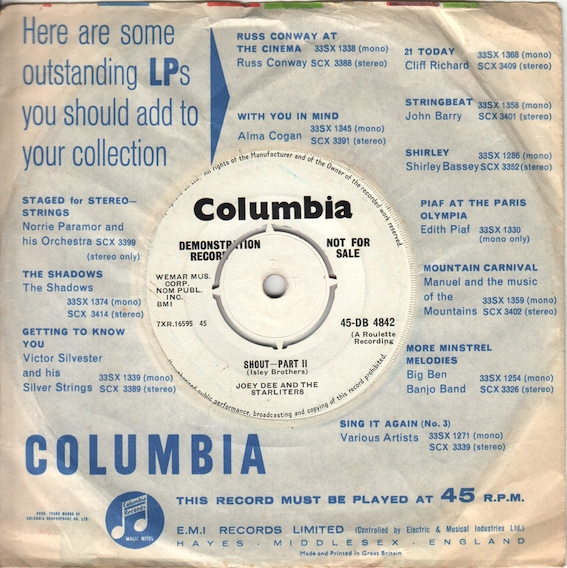
Shout – Part 1: Joey Dee & The Starliters DB4842 demo A side June 1962
Shout – Part II: Joey Dee & The Starliters DB4842 demo B side, reverse sleeve
Yes, there’s a lot of Joey Dee and The Starliters, very much a favourite band.
SEE LINK: JOEY DEE & THE STARLITERS
1962-1963 is Columbia’s peak, before The Beatles on Parlophone took over. Columbia discs topped the UK charts for 31 weeks out of 52 in 1962: Stranger On The Shore, The Young Ones, Let’s Twist Again, Wonderful Land, I Remember You, Lovesick Blues, The Next Time.
1963 starts well, and Columbia still had 22 weeks at number one. Dance On, Summer Holiday, Foot Tapper, How Do You Do It, I Like It, I’m Confessin’, You’ll Never Walk Alone.
The ‘stripes’ sleeve is one of the easiest of all to match to a year. 1962. Many collectors keep a spare sleeve box, and there are usually a lot of the stripes sleeve in them, which is down to Cliff, The Shadows and Frank Ifield having major hits all that year.
plain sleeves
See also the EMI ‘Plain 45 sleeves’ section for more on black centre discs from December 1962.

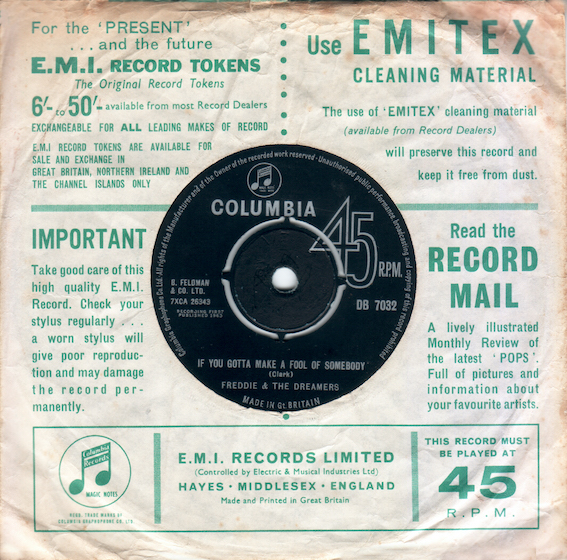
How Do You Do It?: Gerry & The Pacemakers, 1963, DB4987 plain green sleeve, Dec. 1962 to Nov 1964
If You Gotta Make A Fool of Somebody: Freddie & The Dreamers 1963. DB7032 Reverse of first plain sleeve, used on several EMI
By December 1962, the plain green sleeve and black centre had appeared. Once Columbia had settled on the black centre label design, it lasted eight years. This makes later Columbia records difficult to match with sleeves. It’s not helped by Columbia becoming the Middle of the Road repository for EMI, which means such a large proportion of spectacularly uncollectable records were on Columbia. On the plus side, old Columbia sleeves from every era are very easy to find in good condition in charity shops. Tears, Two Little Boys, Grandad, Morningtown Ride … Cliff Richard, Des O’Connor, Frank Ifield, The Seekers, later Rolf Harris, the renowned whistler, Roger Whittaker … these are the contents of cardboard boxes in charity shops across the land. Why pay 41p for a replica sleeve, when you can get a perfect one on a Ken Dodd single for 20p? (I wrote that ten years ago – now make it 50p to £1) Give the record back to the shop … they sell singles without sleeves too. The records are often in excellent condition. Perhaps because many were bought by people who don’t like music … no, that’s hardly fair. It’s because they sold in massive quantities and often got to number one in late 60s charts between The Beatles and Jimi Hendrix.


The House of The Rising Sun: The Animals, DB7301 June 1964 pea green
I’m Crying: The Animals, DB 7354, September 1964 (dated 21st) lighter green
In 1963, EMI decided to go for twin logos: Columbia and EMI rather than just Columbia. This move to emphasize group identity runs across all the EMI labels. The twin logo sleeves are a lighter green, but see The Animals discs above. The colour change had already happened in Summer of 1964.


I’m Into Something Good: Herman’s Hermits DB7338 twin logo sleeve, curved top Lighter pea green
Your Hand In Mine: Herman’s Hermits B-side. Reverse has 6/- tokens side glued


Yeah, Yeah: Georgie Fame & His Blue Flames, December 1964. DB7428, logos slightly larger, and on left. Nov 64 to summer 65 (& reappears later too)
We’ve Gotta Get Out of This Place: The Animals July 1965. DB 7639 Reverse of two logo sleeve. Bottom glued, not side glued
Our task in this book was lightened by finding a box of 120 excellent 1960s singles in a market. All were middle of the road, more than forty were Columbia, and they were 50p each. About six were picked out because it was obvious that the previous owner had assiduously matched sleeves to singles and they all had the right dealer applied catalogue numbers on the sleeves. Three pounds was offered, and the stallholder said, ‘Tell you what … give me a fiver. You can have the lot.’ Each of the six Elvis singles in there were worth that much. The mint Mary Hopkins ones on Apple slightly more. It’s a collector’s dream … all those singles at around 5p each. And a stallholder’s dream too … ‘I dumped all those crappy Frank Ifield and Ken Dodd singles on this prat for a fiver.’
Dating later Columbia sleeves accurately involves nerdy nitpicking. We can only ever be 100% certain on sleeves where the title or number is written on, and with exact dates, and most especially ones we bought ourselves. A lot of the clues are on the reverse, which was given over to advertising. Initially, this was for EMI Record Tokens (from 6/- to 50/-, i.e. 30p to £2.50) and Emitex cleaning cloths. On later sleeves, the base price of tokens had risen to 7/3d. The work has all been done on EMI’s Parlophone label by the Rare Record Guide, fuelled by interest in The Beatles and high values. Columbia is a hazier area, basically because there are few singles where obsessively exact matching affects values. By obsessively exact, we mean going into details such as straight, indented or wavy top edges, or whether the sleeve is folded and glued at the sides or at the foot, and whether the correct first pressing advert is on the rear. That counts with Beatles Parlophone singles. With Columbia a broader match is acceptable.
Singles cost 6/8 in July 1966. That was up from 6/7 1/2 in 1962. A halfpenny inflation in four years. They were 7/- in November 1966 and 7/4d in February 1967. Strawberry Fields Forever was my first 7/4d single. A year later, Hey Jude was 8/4d. And they talk about inflation! So the 7/3d token advert arrived in 1967.
Advertising on sleeves was a significant 1963 move, starting on the reverse and leading to “all advertising” sleeves. The make-up adverts are why there are so many Lulu examples here. EMI thought of her a role-model for the buyers of Miners make-up and Miss Disc perfume.
the pinky-red sleeve


Tears: Ken Dodd Sept. 1965 Pinky-red sleeve. #7659. 6/- record token ad.
The Carnival Is Over: The Seekers Oct 1965 #7711. Morphy-Richards ad as on Tears
At one point we thought there was a red sleeve / green sleeve divide circa 1965 to 1966 with more middle of the road material getting the pinky-red wrapper, and rockier material getting the green sleeves. The Shadows I Met A Girl from 1966 has turned up numbered in both colours. At least three Shadows singles are in pinky-red, but by 1966 that was perhaps the perception of them.
Morphy-Richards was owned by EMI from 1960 on, and made hair dryers and toasters, items which should not be confused. You can’t toast bread with a hair dryer. The reverse is life-threatening. So EMI were advertising an EMI product on Columbia. On Parlophone they were taking outside cosmetics adverts as they would soon on Columbia.
red sleeve


From Head To Toe: The Escorts, July 1966 DB 8061, red rather than ‘pinky-red’ but has same ad as 7659
Blue Turns To Grey: Cliff Richard March 1966 #7866 Morphy Richards ad 2


Pinnochio: Boz 1966, Columbia demo DB7941 With ad #3 on rear: All Set To Go
Someday, One Day: The Seekers March 1966 #7867 with ad #3

Old stock re-used? Ad 2.
The Seekers were the red sleeve red herring, in that they’re closer to easy listening than rock. In fact, Paul Simon wrote two songs with Bruce Woodley of The Seekers, both American hits, and also gave them Someday, One Day, a UK #11 hit which he never recorded himself.
back to green … or red … or green
The Yardbirds were a group. So green. The easy-listening artists were mainly solo vocalists, hence, we guessed, red. The Seekers come in both green (early … a group) and pinky-red sleeves (later … middle of the road) then green (later) so the categories were never fixed and consistent. The Barron Knights Pop Go The Workers from 1965 is in a titled red sleeve, but that’s comedy rather than rock. A Must To Avoid by Herman’s Hermits in 1965 was definitely in a red sleeve. Meticulously numbered sleeves suggest that the pinky-red sleeve with lots of writing (and a right hand logo, with Morphy Richards hair-dryer ads on the back and 6/- record tokens), simply preceded the subsequent green, where record tokens are 7/3d. A copy of My Friend Jack by The Smoke from a carefully matched, well-looked after collection was in the red sleeve, and this was a June 1967 release, long after any others in this sleeve.


Big Time Operator: Zoot Money’s Big Roll Band. #7975 August 1966 EMI ads on front, logos on right. 7/3d record token ad.
Zoot’s Sermon: Zoot Money’s Big Roll Band August 1966. B-side and rear sleeve, with one of several Miners make-up ads
Columbia sleeves on rock material in late 1966 and 1967 is on green sleeves, though with the same detailed information as red sleeves. The adverts are now make-up rather than the red sleeve hair dryers. As with HMV which put fridge ads on easy listening material, but cosmetics on rock, there may be a deliberate choice.


See Emily Play: The Pink Floyd #8214 June 1967 closed centre (same rear as 8060)
Morningtown Ride: The Seekers #8060 November 1966 rear with Miners ad
Pink Floyd are definitely green in 1967. Both Arnold Layne (#20) and See Emily Play (#6) were hits. They now command mint prices of £100 and climbing, which is unusual for Top 20 records, and See Emily Play is hardly rare, but their subsequent success meant a huge interest in the early singles.
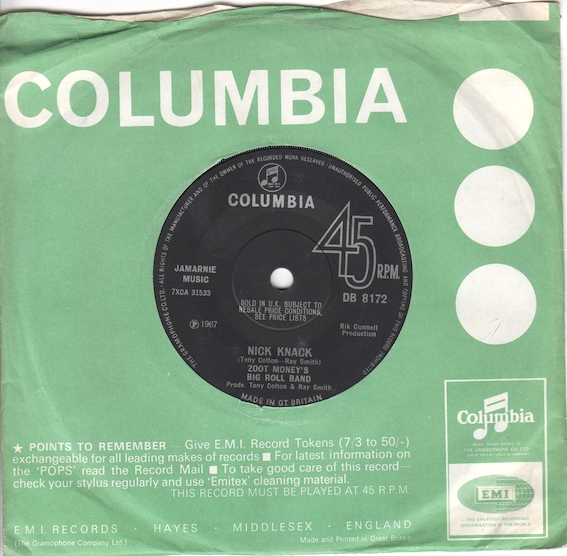

Nick Nack: Zoot Money’s Big Roll Band 1967 #8172 same Miss Disc rear as #8169
Dreary Days & Nights: Lulu B-side April 1967 #8169 with Miss Disc advert


Reflections of Charles Brown: Rupert’s People, 7 July 1967 #8226 same rear as 8169
To Sir With Love: Lulu #8221 June 1967. A #1 US hit, but a British B-side with Miners ad
Reversion to earlier design
The early 1965 two logo green sleeve with Emitex ads on the back was revived in late 1967 at the same time as the blue sleeve with Emitex adverts. They’re different colour versions of the same design. Maybe EMI discovered a warehouse full of unused 1965 sleeves.
So some discs in late 1967 era revert to a plain green “two logo” sleeve, as on my copy of Apples & Oranges by Pink Floyd, November 1967, DB 8310. Difference? Record tokens are 7/3d, not 6/-.

Numbered sleeve, and from a meticulously curated collection


Apples & Oranges: The Pink Floyd #8310, November 1967 reverted design
Paint Box: The Pink Floyd, DB8310 B-side. 7/3d Record tokens, not 6/-
That also has a most desirable demo sleeve … so desirable that sleeve bootlegs abound. (Mint value: £150 as is It Would Be So Nice.)


blue sleeves
The early 1967 blue sleeves have the same design as the ‘revived green’ sleeve.


Love Loves to Love Love: Lulu 1967 #8295 Squared corners to logo
You and I: Lulu. Rear of Lulu 1967 #8295 sleeve with Emitex advert, bottom glued


Maroc 7: The Shadows DB8170. Unusual non-push out centre, with a much larger title font
London’s Not Too Far: Hank B. Marvin DB 8326. Same rear, bottom and one side glued.
There are (at least) three different blue sleeves. The early ones have a large square logo with a 7/3d Record Token / Emitex advert on the back. They appear at a point where the green sleeve was shifting from the logo on the left to a smaller logo on the right in July 1966. The newer green sleeves started the cosmetics ads on the back, so the blue probably inserts itself between them.


She Wears My Ring: Solomon King rounded corners to smaller logo #8325
I Get That Feeling Over You: B-side, sleeve reverse with LP adverts
Some copies of Solomon King’s She Wears My Ring from 1967 have a large logo blue sleeve with ads for 1967 LPs on the back. They’re all Columbia LPs too. The 1968 copies have smaller rounded corner logos and also 1967 LP adverts on the back. It may be the blue sleeve single I’ve seen most often of all, and with consistently blue sleeves. Zoot Money’s Big Time Operator is always expensive, so displayed in record stores. There are green ones (as seen above) and blue ones.

In 1967, the Columbia Blue Beat series was introduced, with a yellow label and a plainer design, possibly trying to look more like a ska label than an EMI black “45” design. The first release DB 101 was by The Bees, followed by Laurel Aitken as DB102. The sub-label was run by producer Siggy Jackson, who left Melodisc in 1967 to establish Columbia Blue Beat. Jackson had been involved with Melodisc since 1953, setting up Blue Beat as a label in 1960. Columbia Blue Beat ran for just nineteen titles between 1967 and 1970. Like all ska, reggae and blue beat labels, it’s collectable.
Two Columbia Blue Beat series have turned up in annotated blue sleeves, and it might have been an irresistible match. But the first Blue Beat disc, by The Bees, came after they’d reached the second blue sleeve design.
Perhaps Columbia decided to have different colours to pull people’s attention in browser sections, and there was no rule to the choice, and maybe they were not applied to particular singles but were mixed and matched. Whatever, blue didn’t get used as much. It is an exact ‘Stateside blue’.
1967 demo:
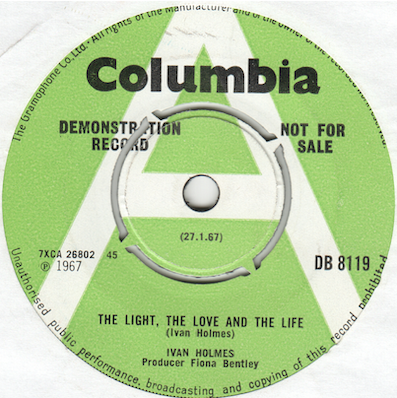

The Light, The Love & The Life: Ivan Holmes demo, January 1967 A-side DB8119
Cocaine : Ivan Holmes demo, January 1967 B-side
Colour LP adverts sleeve
The push-out centre has gone.


All My Love: Cliff Richard 1967 DB 8293 Columbia ‘advertising sleeve’ front. No push-out centre
Myra: The Seekers 1967 Columbia ‘advertising sleeve’ back.
When you can’t sell ads to anyone else, advertise yourself. In 1967 a sleeve was introduced with colour LP adverts on both sides. This is an EMI sleeve, NOT an exclusive Columbia one. It’s a move towards an EMI single group sleeve.
Most LP advertising sleeve examples are Columbia titles, but the adverts cover Parlophone and Capitol artists as well. Ode to Billie Joe by Bobbie Gentry was Capitol, and early copies were in the same sleeve. Tamla had a separate version advertising only Tamla albums. I’ve found United Artists discs in this sleeve too.
Scarlet sleeve
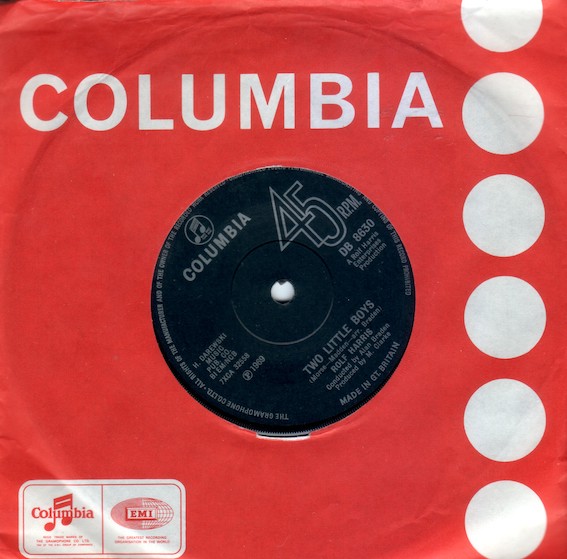

Two Little Boys: Rolf Harris November 1969 Columbia 1968-72 scarlet-red sleeve 1968-1972 Centre label unchanged since late 1962
Nevertheless: Frankie Vaughan, February 1968 DB 8354, rear of first scarlet sleeve, wavy top. Same adverts as blue sleeve
As HMV was defunct as a popular label from 1967, Columbia got a scarlet sleeve, very much like the HMV one, but now with LP adverts on the back. This ran for four years, but the LP selection only got updated once, and that was pretty soon in the run. The earlier sleeve has LPs with 6157 to 6201 catalogue numbers.


Sacha: Hank Marvin DB 8601 numbered sleeve, July 1969
Sunday for Seven Days: Hank Marvin July 1969 DB 8601, second set of rear ads
The later rear selection of LP adverts sleeve has 6216 to 6282 numbers, so not a long gap, but must be post June 1968. I’d identify them as:
Early rear sleeve … Pink Floyd, Piper at the Gates of Dawn on left.
Later rear sleeve … Pink Floyd, A Saucer Full of Secrets on left.
A dealer was perplexed by this and said, ‘No, early is Cliff Richard Good News, later is The Rolf Harris Show.’
From mid 1968 this appears to be the only sleeve in use. The artists highlighted in the LP adverts show the label’s self-image: The first has Ken Dodd, Lulu, The Seekers, The Shadows, Cliff Richard, Pink Floyd and Frankie Vaughan. The second has Cliff Richard, Hurricane Smith, The Gods (later members joined Uriah Heep), The Black & White Minstrel Show (still going and migrated from HMV, perhaps on a slave ship), Pink Floyd, Rolf Harris, The Seekers. They say it pays to advertise, but apparently not in The Gods’ case. In spite of four years sitting on the Columbia sleeve, the album (Genesis) is now so rare that copies go for £250.


Ernie (The Fastest Milkman In The West): Benny Hill 1971. DB 8833. EMI logo appears on centre
Sunny Honey Girl: Cliff Richard 1971 DB 8747, rear of late red sleeves with scooped indent top and ads
Cliff Richard’s last Columbia single in November 1972 was A Brand New Song, notable for being almost his only-non-charting single. His next, Power to All Our Friends in March 1973, was in an EMI sleeve. In July 1972, Rolf Harris’s Tutankhamun (cashing in on the exhibition in London) had a picture sleeve with only the EMI logo, but the disc inside had a Columbia label.
More colours?


Let’s Pretend: Lulu 1967 Oh, no, not a black one too! (It’s Australian, never used in UK)
Light blue! Probably between 1963 and 1967. New Zealand Columbia sleeve. New Zealand used the EP centre design on singles.
The Columbia name was dropped in late 1972, and Columbia artists all became plain EMI (see EMI). The last three number ones were Rolf Harris with Two Little Boys, Clive Dunn with Grandad and Benny Hill with Ernie (The Fastest Milkman in The West). Columbia had taken over Parlophone’s role as comedy / novelty label. Rolf Harris’s Two Little Boys was a tearjerker rather than comedy, but until then he’d been known for comic records. It was Margaret Thatcher’s favourite record. I think his prison sentence was for two little girls.
EMI’s Past Masters series in the1980s had a common Columbia / HMV / Parlophone sleeve design with blue disc labels:

The name appeared to be defunct, but appeared again in 1978 on Middle of the Road / Archive material. Some of it was in the Nostalgia ain’t what it used to be vein that United Artists were mining. DB 9050 was Marlene Dietrich.
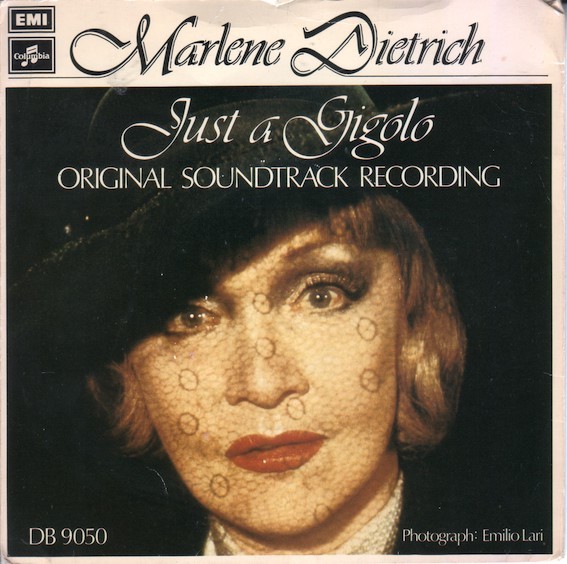

Just A Gigolo: Marlene Dietrich, 1978 release DB 9050, picture sleeve
The most successful was Iris Williams vocal take on (He Was So Beautiful) Cavatina (DB9070) from the film The Deer Hunter.

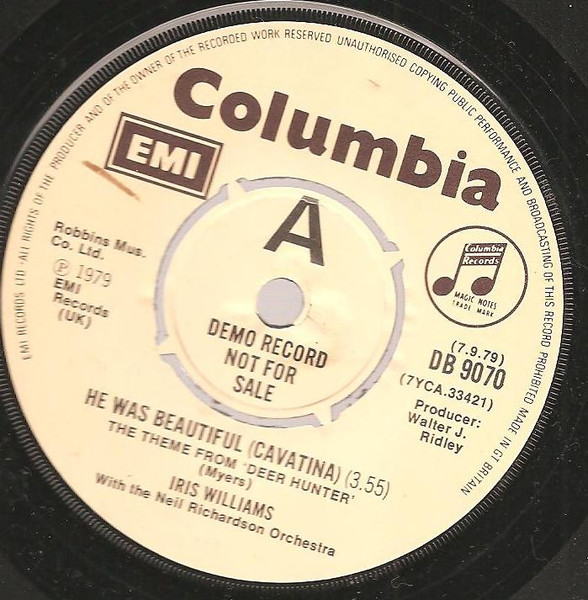
He Was Beautiful (Cavatina): Iris Williams Columbia DB 9070 1979
Sell-through copy and lighter coloured demo copy.
In between came Bernie Winters with a comedy How d’you do.
Cliff Richard 1982 reissue series
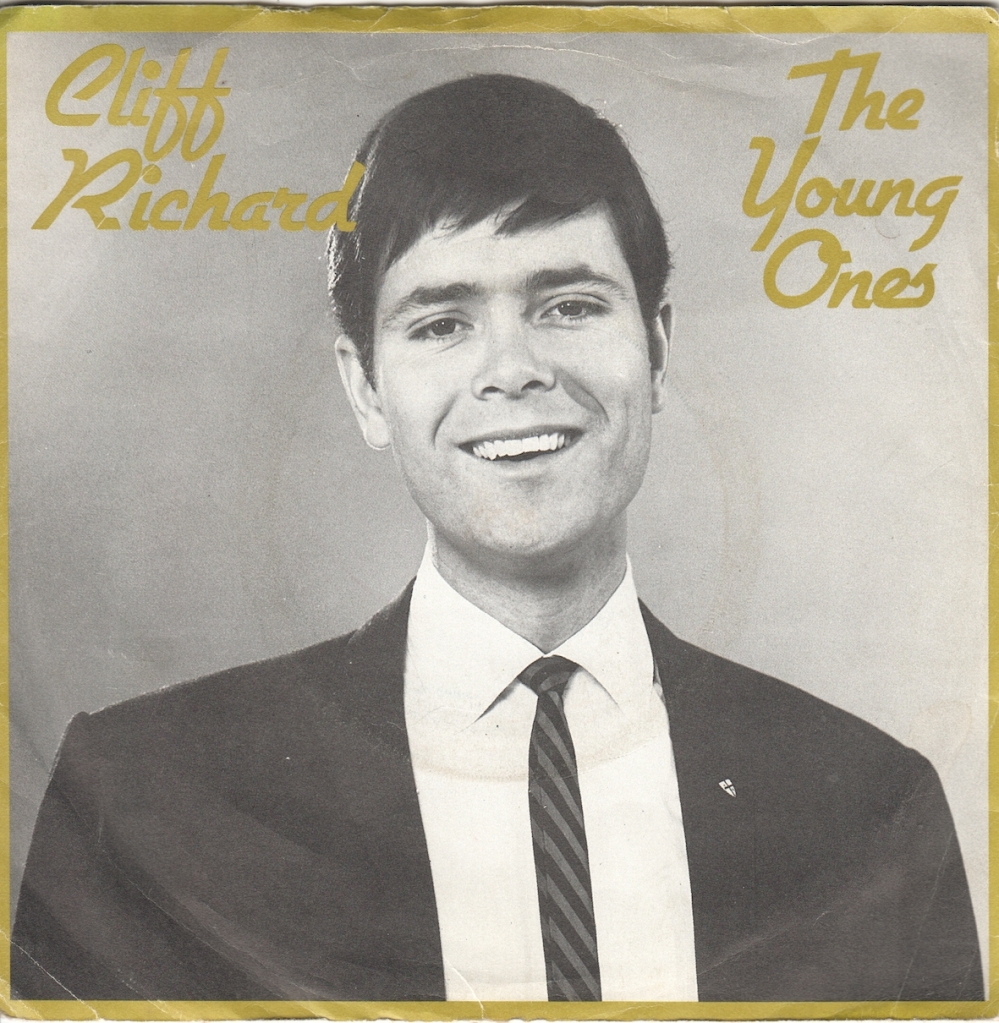


The Young Ones: Cliff Richard & The Shadows 1982 reissue, DB 4761. It was produced with both solid and push-out centres. Green, as original was green.


The Next Time / Bachelor Boy: Cliff Richard & The Shadows 1982 reissue DB 4950. Black label, as the original was black
Replica style Cliff Richard singles also carry the Columbia name on EMI.
In the end …
The last EMI Columbia label we have found is on Soulsister’s The Way To Your Heart in 1989 (DB9175).


The Way To Your Heart: Soul Sister Columbia DB9175, 1989
In 1988, after Sony had bought American Columbia / CBS, the rights to the Columbia name outside North America and Japan were acquired by Sony. Records labelled Columbia after 1988 should be ones issued by the US company, part of the Sony group, and from 1993 the musical notes logo belonged to Sony / CBS again.
The 1989 Soul Sister release looks as if it was after the changeover.


Soul (EP): Georgie Fame 2015, note Columbia style design

In 2015, Universal-UMC – Polydor effectively owned the old EMI Columbia catalogue. An interesting ploy was to re-instate the “notes” logo, but call it SOUL. The Georgie Fame 2015 EP for Record Day has tracks from 1966 and proclaimed in “a Columbia-style sleeve.” The centre design is the same as Columbia 60s EPs with “Georgie Fame” in place of Columbia. Maybe even the 33 rpm was an attempt to avoid prosecution for passing off the 45 rpm logo.
SEE ALSO:
Columbia (EMI)
Columbia (EMI) – 45 sleeves and designs
Columbia Clef
Columbia Lansdowne